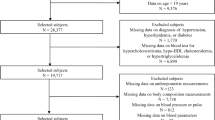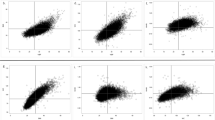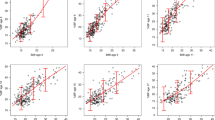Abstract
Objective:
To compare the distributions of body mass index (BMI) in relatively healthy nonsmoking men and women in the United States.
Design:
Cross-sectional national survey data from the Third National Health and Nutrition Examination Survey (NHANES III).
Subjects:
In total, 11 404 nonsmoking men (n=4894) and women (n=6510), ages 20 years and above, drawn from a representative population sample.
Measurements:
Increasingly stringent definitions of ‘health’ were applied, based on self-reported health, medical history, measurements of blood pressure, blood lipids, serum glucose, glycosylated hemoglobin, and behavioral factors including smoking and physical activity. Main outcome measures were mean and median BMI by health level, 5th and 95th percentiles of BMI, and the prevalence of overweight and obesity.
Results:
For both men and women, the distribution of BMI became less skewed at better health levels. The range of BMI values that included 90% of healthy men and women was approximately 19.5–30 kg/m2 for men and 18–30 kg/m2 for women, with median values of approximately 24.5 kg/m2 for men and 21.5 kg/m2 for women. The prevalence of overweight declined sharply with increasing health level for women but varied little for men; the prevalence of obesity declined at higher health levels for both men and women.
Conclusions:
Only about 5% of healthy younger men or women would be classified as obese by BMI levels. However, the distribution of BMI differs between healthy men and healthy women. Relative to the distribution of BMI values for healthy men, the distribution of BMI values for healthy women is shifted to the left and is more skewed.
This is a preview of subscription content, access via your institution
Access options
Subscribe to this journal
Receive 12 print issues and online access
$259.00 per year
only $21.58 per issue
Buy this article
- Purchase on Springer Link
- Instant access to full article PDF
Prices may be subject to local taxes which are calculated during checkout





Similar content being viewed by others
References
Metropolitan Life Insurance Company. New weight standards for men and women. Stat Bull 1959; 40 (November–December): 1–4.
Metropolitan Life Insurance Company. Metropolitan height and weight tables. Stat Bull 1983; 64 (January–June): 2–9.
National Institutes of Health Consensus Development Panel on the Health Implications of Obesity. Health implications of obesity: National Institutes of Health Consensus Development Conference Statement. Ann Intern Med 1985; 103: 1073–1077.
WHO Expert Committee on Physical Status: the Use and Interpretation of Anthropometry. Physical status: the use and interpretation of anthropometry. Report of a WHO expert committee. World Health Organization: Geneva, 1995. (World Health Organization Technical Report Series; 854).
NHLBI Expert Panel on the Identification Evaluation and Treatment of Overweight and Obesity in Adults. Clinical Guidelines on the Identification, Evaluation, and Treatment of Overweight and Obesity in Adults – The Evidence Report. National Institutes of Health [published erratum appears in Obes Res 1998 Nov;6(6):464]. Obes Res 1998; 6 (Suppl 2): 51S–209S Also available at http://www.nhlbi.nih.gov/guidelines/obesity/ob_gdlns.htm (accessed March 9, 2005).
Garrow JS . Treat Obesity Seriously: A Clinical Manual. Churchill Livingstone: Edinburgh, 1981.
Bray GA . In defense of a body mass index of 25 as the cut-off point for defining overweight. Obes Res 1998; 6: 461–462.
Bray GA . Definition, measurement, and classification of the syndromes of obesity. Int J Obes 1978; 2: 99–112.
U.S. Department of Agriculture and U.S. Department of Health and Human Services. Nutrition and Your Health: Dietary Guidelines for Americans. Home and Garden Bulletin No. 232. US Government Printing Office: Washington, DC, 1980.
U.S. Department of Agriculture and U.S. Department of Health and Human Services. Nutrition and Your Health: Dietary Guidelines for Americans. Home and Garden Bulletin No. 232. U.S. Government Printing Office: Washington, DC, 1985.
Norgan NG . The beneficial effects of body fat and adipose tissue in humans. Int J Obes Relat Metab Disord 1997; 21: 738–746.
National Center for Health Statistics. Plan and Operation of the Third National Health and Nutrition Examination Survey, 1988–1994. National Center for Health Statistics: Hyattsville, MD, 1994. (Vital and Health Statistics Series 1; No. 32).
Flegal KM, Troiano RP . Changes in the distribution of body mass index of adults and children in the US. Int J Obes Relat Metab Disord 2000; 24: 807–818.
Velleman PF, Hoaglin DC . Applications, Basics and Computing of Exploratory Data Analysis. Duxbury Press: Boston MA, 1981.
Brown CD, Higgins M, Donato KA, Rohde FC, Garrison R, Obarzanek E et al. Body mass index and the prevalence of hypertension and dyslipidemia. Obes Res 2000; 8: 605–619.
Author information
Authors and Affiliations
Corresponding author
Additional information
The findings and conclusions in this report are those of the author and do not necessarily represent the views of the funding agency.
Rights and permissions
About this article
Cite this article
Flegal, K. Body mass index of healthy men compared with healthy women in the United States. Int J Obes 30, 374–379 (2006). https://doi.org/10.1038/sj.ijo.0803117
Received:
Revised:
Accepted:
Published:
Issue Date:
DOI: https://doi.org/10.1038/sj.ijo.0803117
Keywords
This article is cited by
-
A systematic review: normative reference values of the median nerve cross-sectional area using ultrasonography in healthy individuals
Scientific Reports (2022)
-
Waist circumference of healthy men and women in the United States
International Journal of Obesity (2007)



